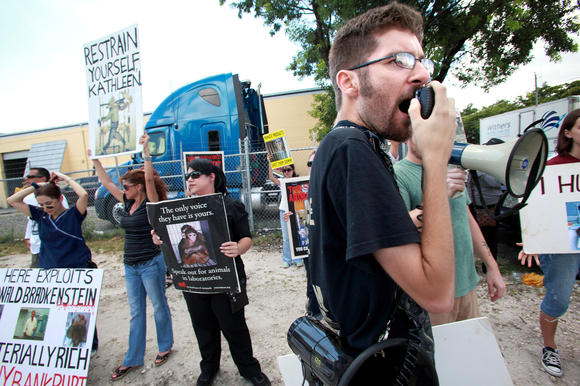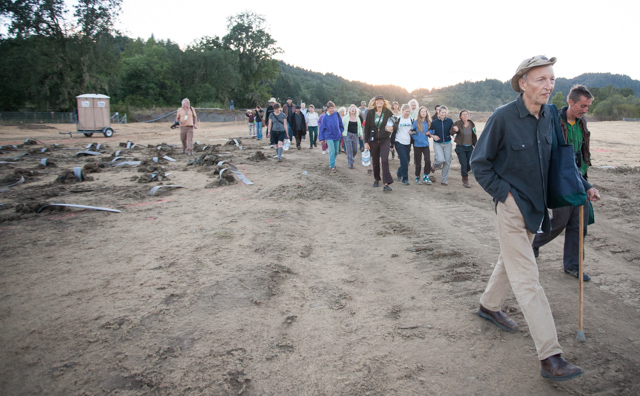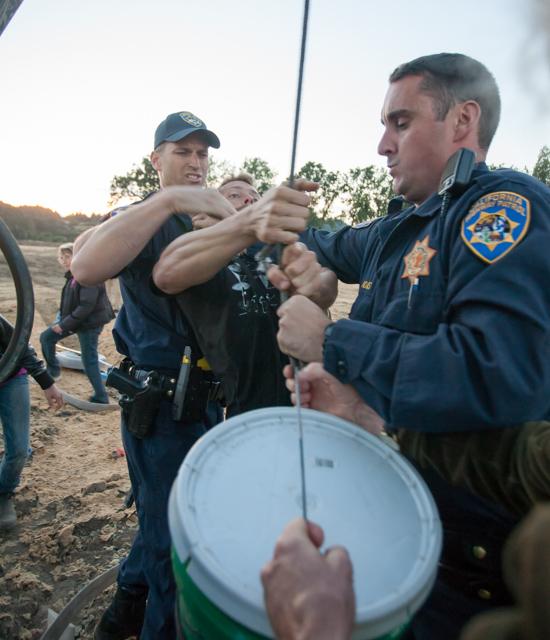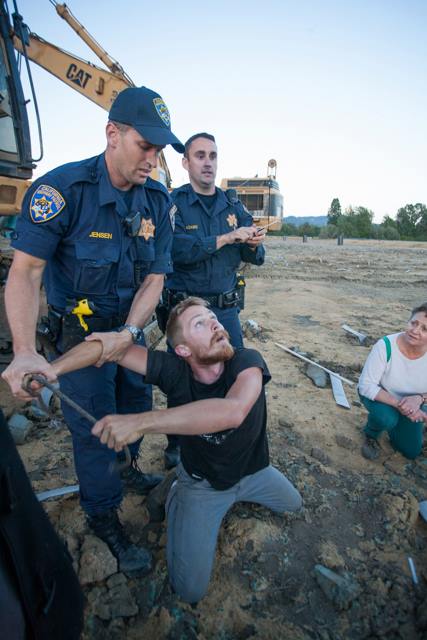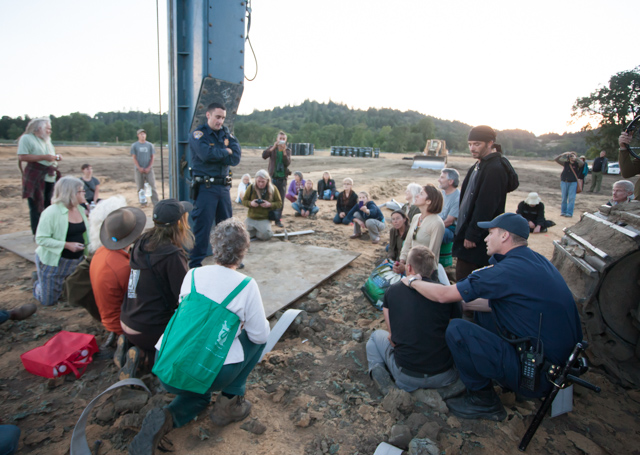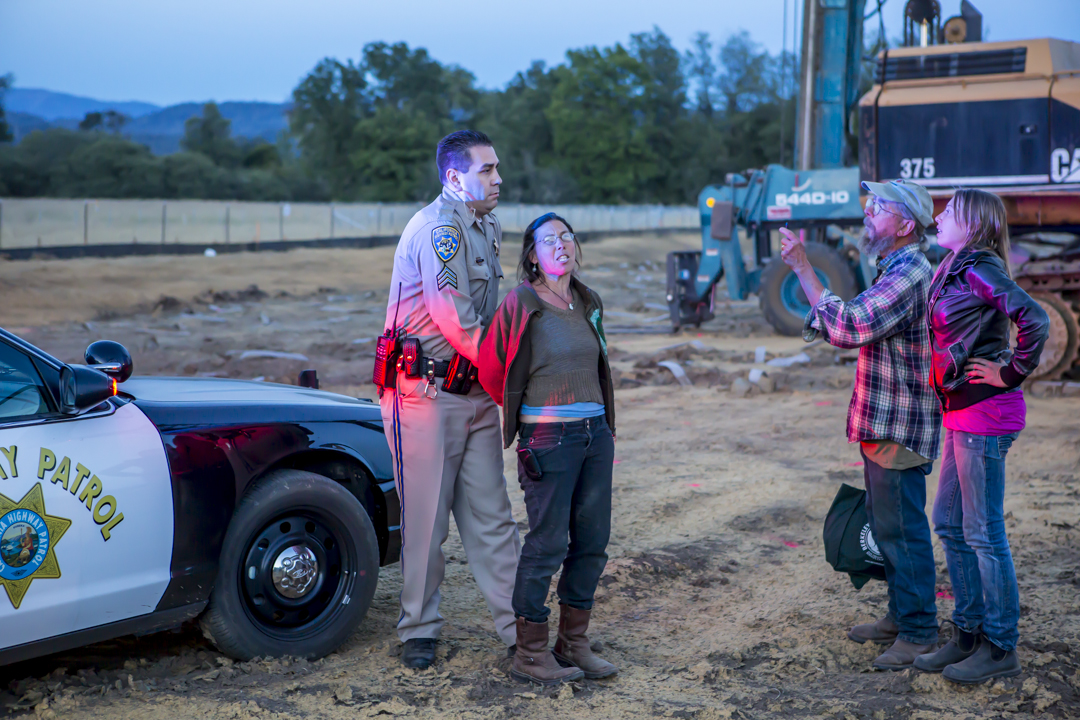25 June 2013 Community Member Hit by Car, Sovereignty Summer Campaign Calling for National Solidarity Actions
By Sunday, June 23rd, SWN Resource Canada’s highly contested and protested seismic testing along highway 126, in Kent County, New Brunswick, had almost wrapped up.
But the seismic test along the highway is only one of several planned testing lines, and the company’s attempts to begin another line of seismic testing – this time along the back roads of Kent County – was yesterday halted in its tracks by community members living in the vicinity of Browns Yard.
SWN’s seismic testing of the back roads areas of Kent County – conducted with All-Terrain Vehicles known as ‘Bombadiers’, and dynamite charges – is slated to be extensive, with approximately 150kms of testing expected to take place.
Yesterday’s resistance, conducted firstly by local families and the action group known as ‘Upriver Environment Watch’, suggest that SWN’s task in the woods of New Brunswick, where there is local knowledge, deep forests and intense opposition to the testing, will be a tough slog indeed.
At about 2pm, an SWN-contracted truck with a trailer parked itself along highway 490. The truck was abandoned by the SWN-contracted workers, but it was an announcement of their presence to the vigilant community.
A small group of local familities – about 15 people in all, including young children – then gathered. A Bombadier, two geophones, a surveyor’s tripod and a SWN antenna, were spotted. Whoever had positioned the equipment had done so on a private piece of land adjacent to the dirt highway.
The driver of the Bombadier approached the surveying equipment, potentially to recover it from the gathering crowd, only to be chased away from the equipment by the crowd. The driver sped south along a dirt road and did not return to the scene.
An SWN-contracted security truck appeared on the scene about ten minutes later. The driver of the truck did not speak to the gathered crowd, but as he was driving away he struck local resident Dave Morang hard enough with his driver’s side mirror to bend the mirror backwards. The driver did not stop.
Morang, injured, requested that an ambulance needed to be called. An Emergency Response team later took Morang to hospital on a spinal board and a stretcher. His condition is currently unknown.
“I can’t believe they didn’t stop,” Morang told the Halifax Media Co-op before the ambulance arrived. “They hit me hard enough with his mirror that it bent it. He would have known that. How many laws can they break?”
About 20 minutes later, RCMP appeared in force, with 26 officers and 14 cars and paddy wagons stationing themselves along the dirt road. The call through social media, however, had beaten them to the punch, and by the time they arrived the gathered crowd had swelled to about 100 non-Indigenous and Indigenous people.
RCMP consulted for about twenty more minutes, before apparently deciding that the best course of action would be to pick up SWN’s antenna and geophones. Photographs indicate that SWN’s equipment appears to have been somehow bent and otherwise broken.
With nothing left to do, and with a gathered crowd which now included Chief Aaren Sock of Elsipogtog First Nation, the police packed up and retreated down the dirt road from which they had appeared.
Chief Sock, whose band council late Saturday night issued a Band Council Resolution inviting United Nations Observers to Elsipogtog, was not impressed with SWN’s unwanted incursions into Kent County, or the arrests of his people while in ceremony.
“Message for SWN: You’re not welcome in my territory,” Sock told the Halifax Media Co-op. “Nothing personal.”
After the RCMP departed with SWN’s equipment, those gathered continued to cheer and drum. They then began to slowly trickle back to their respective communities.
It was later discovered that SWN’s abandoned truck – the original sign of their presence – had had its windows smashed, doors dented and bumpers knocked off. As of press time, it is not known how this damage might have happened.
A packed community hall meeting in Elsipogtog, open to the general public, took place later in the evening. The topic of the meeting was not only how to stop SWN, but how to get shale gas out of New Brunswick, and all of the Maritimes. With UN observers now in place, representatives from various Warrior societies from across the Maritimes have been welcomed to Elsipogtog. They were greeted at the meeting with a standing ovation.
Local man Dave Morang was injured by an SWN-contracted security truck, who failed to stop after hitting him. [Photo: Miles Howe]
Police removing SWN equipment, which seems to have been bent somehow.[Photo: Miles Howe]
RCMP moving SWN equipment. [Photo: Miles Howe]
Not sure how this happened. SWN-contracted truck gets trashed. Last seen being towed away.[Photo: Miles Howe]
——————————
Cross Posted from Idle No More
This is an official notice and “Call Out” to all Idle No More & Defenders of the Land – Sovereignty Summer – activists, allies and supporters, and partnership organizations to act in aid and in the defence of grassroots Elsipogtog First Nation, families, community members, and supporters near Moncton, New Brunswick.
In the last few weeks, Elsipogtog First Nation community members and allies have taken peaceful action to prevent seismic testing vehicles and workers from testing for shale gas deposits for purposes of resource exploitation on Indigenous territories.
The protestors have remained strong and peaceful for numerous days and the RCMP have become more aggressive and violent; arresting a man as he held a sacred pipe in his hand, as well as arresting community members at the site of the sacred fire. SWN contractors have also threatened to run over Mi’kmaq youth at the site.
In total, this past weekends Aboriginal Day’s 12 arrests brings the total number of arrestees to 29 from both the Mi’kmaq and non-Indigenous communities at the location of a sacred fire being kept (located at the junction of highways 126 and 116 west) in Kent County near Moncton. These arrests included the arrest of a eight and a half month pregnant Mi’kmaq woman as well as local man, Dave Morang. Mr. Morang was injured by an SWN-contracted security truck, who failed to stop after hitting him.This peaceful resistance is on-going to prevent SWN Resources Canada from fracking in the immediate area.
INM organizers have been in contact with Elsipogtog First Nation community members and have requested further support.
Sovereignty Summer Campaign-Idle No More & Defenders of the Land
